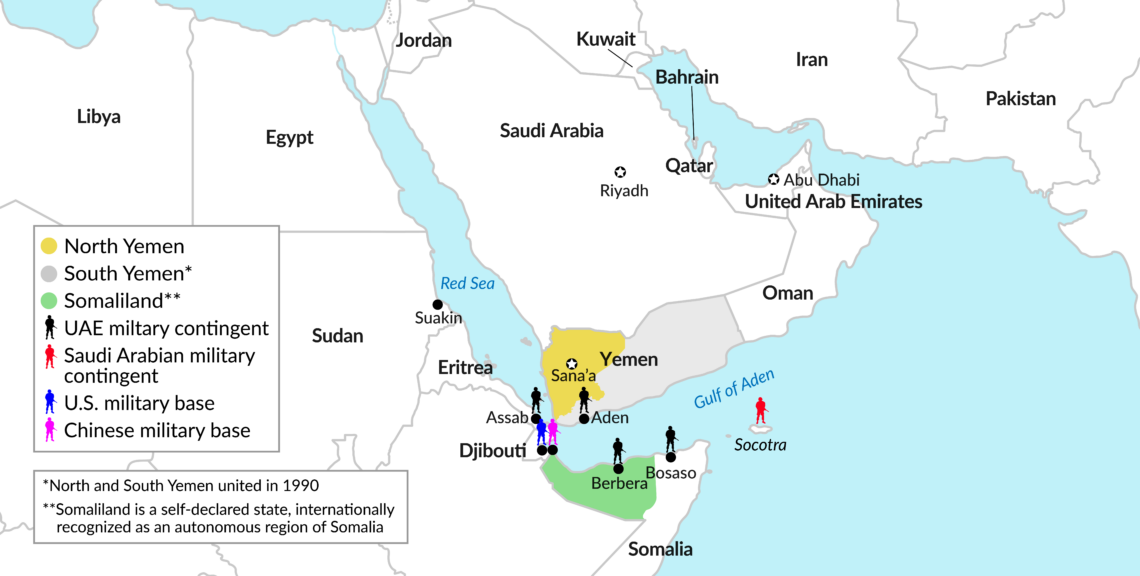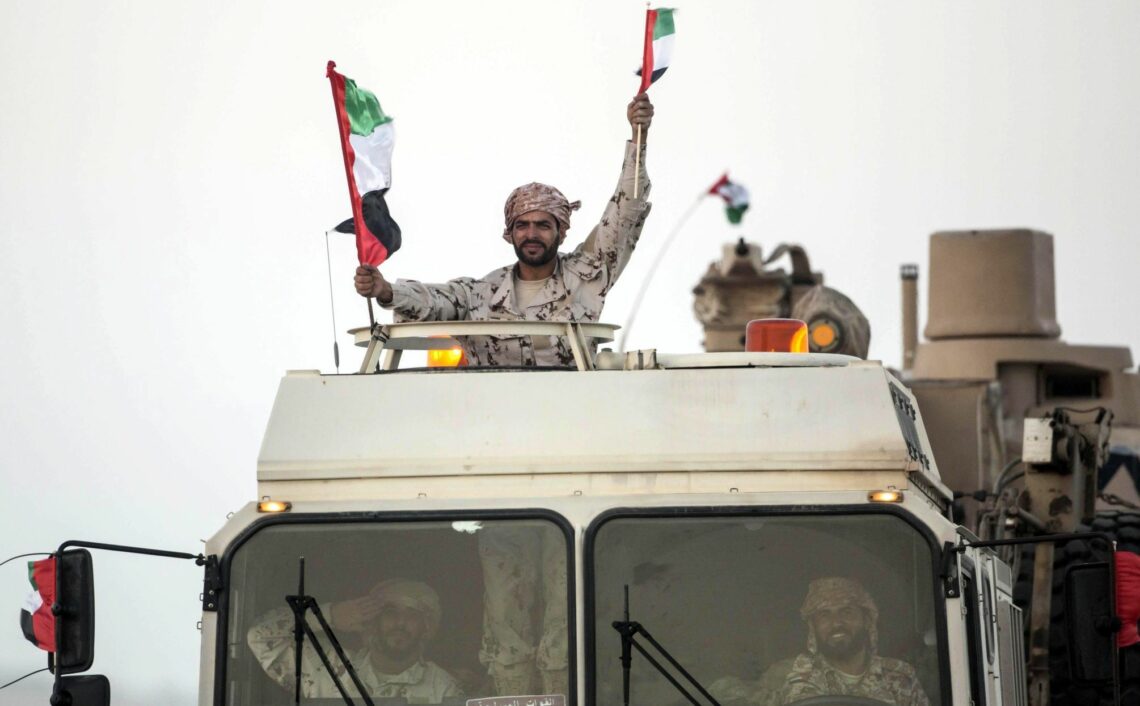Saudi Arabia and the UAE have diverging goals in Yemen
Recently, it has become clear that Abu Dhabi’s and Riyadh’s goals in Yemen are diverging. While both the Emiratis and Saudis want to roll back Iran’s influence in the region, the UAE wants to divide Yemen, so it can gain more control around critical access points to the Red Sea.

In a nutshell
- The UAE’s goals in Yemen are increasingly divergent from Saudi Arabia’s
- Abu Dhabi wants a divided Yemen, while Riyadh wants to keep it whole
- These tensions will grow more acute and complicate the conflict
- Greater UAE influence around the Horn of Africa could blunt terrorism there
At the beginning of May, troops, armor and materiel from the United Arab Emirates landed on the Yemeni island of Socotra, strategically located at the entrance of the Gulf of Aden, just north of Somalia. The development exposed an important set of geopolitical dynamics in the Yemen conflict, as the main protagonists try to maximize their advantage.
The UAE is part of a Sunni coalition led by Saudi Arabia to fight the Houthi rebels, whom Iran has been actively supporting. Iran has several objectives in backing the Houthis. Mainly, it wants to complete its encirclement of the Persian Gulf, gain access to the Red Sea and control this crucial maritime choke point through a presence on the Gulf of Aden and the Red Sea coast. This push also serves to drain Saudi Arabia’s and the UAE’s resources, helping minimize their engagement in Syria.
The Saudis and the UAE decided to make their stand in Yemen, because Iran already exerts de facto control of Iraq and Lebanon, while it has gained considerable leverage in Syria. They also resolved to prevent Iran from controlling access to the Red Sea. Despite the Saudis and the Emiratis executing a large-scale military campaign, the Houthis held onto large swaths of Yemen, and last year even managed to enter Sana’a, the capital, killing former President Ali Abdullah Saleh.
There is a widening gulf between Riyadh’s and Abu Dhabi’s goals in Yemen.
The coalition officially supports the internationally recognized government of President Abd Rabbuh Mansur Hadi and Prime Minister Ahmed bin Daghr, who spend much of their time in the Saudi capital, Riyadh, and whose salaries and expenses are reportedly paid by the Saudis.
Diverging objectives
However, there is a widening gulf between Riyadh’s and Abu Dhabi’s goals. The Emiratis seem to have lost confidence in President Hadi and have been promoting former President Saleh’s son. Moreover, they have been working for more autonomy for southern Yemen.
These machinations have been taking place alongside the coalition’s main mission to defeat the Houthis, thwarting Iran’s ambitions in Yemen and enabling the return of the internationally recognized Yemeni government. Defeating the Houthis will also eliminate the threat of missiles being fired from inside Yemen toward population centers in Saudi Arabia and possibly the UAE.
The UAE has also pursued a security and trade strategy around the Gulf of Aden and the Horn of Africa. This strategy has culminated in the deployment of its military on Socotra and the takeover of key infrastructure on the Socotra archipelago, including ports and airports. The UAE has used soft power (mainly funding and development in parts of southern Yemen) as well as hard power (such as creating regional Yemeni militias under its ultimate command). It has also supported political movements aimed at combating the Muslim Brotherhood’s influence in Yemen.
The UAE has focused on enhancing its presence in southern Yemen around Aden and effectively recreating a quasi-independent region – North Yemen and South Yemen were separate republics until their unification in May 1990. The southern and northern parts of Yemen have little in common. The south, with a long coastline on the Arabian Sea, has a cosmopolitan history as a trading and seafaring region. The north, with its rugged, inhospitable topography deep in the interior of the Arabian Peninsula, has a history of warring tribes, little formal education, and religious and social conservatism.

In contrast, Saudi Arabia has focused almost exclusively on fighting the Houthis to prevent Iranian hegemony. It wants Yemen to remain united. From Riyadh’s perspective, stabilizing the countries’ turbulent border region will be easier if it can deal with a single Yemeni government that it sponsors and which controls all of the country’s territory.
Counterterrorism strategy
The UAE’s soft power approach to southern Yemen, including the island of Socotra, has been impressive: over the past few years it has funded education, health care, housing and job creation to the tune of billions of dollars, doled out through its two main charitable foundations, the UAE Red Crescent and the Khalifa Fund.
The latter set up a specialist arm, the Khalifa Fund for Enterprise Development in South Yemen, with $30 million for southern Yemenis wishing to set up a new business or needing compensation for businesses lost due to the war. It also funded the expansion of the port of Haulaf, which was inaugurated in March 2018, specifically to promote maritime commerce on Socotra.
There is more than trade driving Abu Dhabi’s strategy. Funding development not only enhances the UAE’s geopolitical presence but also helps prevent poverty and backwardness, denying Islamist terrorist organizations fertile terrain for operations and recruitment. The UAE focused on Socotra due to its unique strategic location, near the Somali coast and effectively controlling access to the Red Sea. It has allowed Socotra’s residents to travel, visa-free, to the UAE, and there are regular flights between the island and the UAE.
The UAE’s military deployment to Socotra took place as Yemeni Prime Minister Ahmed bin Daghr was visiting the island and after the internationally recognized Yemeni government had made Socotra a full-fledged governorate.
Whoever controls this archipelago will also control a key access point for global trade.
The Emirati troops were reported to have prevented Prime Minister bin Daghr from departing. The Yemeni government quickly asked the Saudis to intervene and filed a formal complaint to the United Nations, criticizing the UAE’s “unjustified military actions” (some Yemenis even considered it an occupation). Many rounds of negotiations later, the UAE’s troops left but were replaced by a Saudi military contingent. There are no Houthi rebels on the island, and the UAE and Saudi deployments have no link to the proxy fight against Iran in Yemen. They can only be interpreted as part of a parallel geopolitical strategy for the Horn of Africa region.
The UAE’s other deployments are the sharp end of a dual strategy to take the fight to the jihadist terrorist groups around the Horn and to gain maritime and trading advantages along this globally critical sea lane. The UAE has troops in Bosaso, Somalia, at the entrance to the Gulf of Aden; in Berbera, on the coast of Somaliland; in Aden, Yemen; and in Assab in Eritrea.
Its investments developing these areas is the other side of the same counterterrorism coin. This presence also grants the UAE – and its world-class port management companies – tremendous influence at the entrance to the Red Sea.
Global arena
The deployment on Socotra is a reminder that regional conflicts can, and frequently do, spill over into the global arena through largely unintended consequences. Whoever controls this hitherto sleepy, beautiful and environmentally delicate archipelago will also control a key access point for global trade.
It is an open question how China will react to such a move, particularly given its naval base in Djibouti, as well as how the United States and NATO will perceive a Saudi military presence on the island. Turkey, allied with Qatar and on unfriendly terms with the UAE and Saudi Arabia, has denounced both deployments. The latter’s control of Socotra reduces the strategic advantage that Turkey achieved by leasing Suakin island, on the Red Sea, from Sudan.
The horse trading between the Saudis and the UAE will become a fixed feature of the conflict in Yemen.
In this context, the developments regarding the Iran nuclear deal, Tehran’s operations in Syria and U.S. actions throughout the Middle East will directly affect the conflict in Yemen – and by extension trade through the Red Sea and counterterrorism operations in the Horn.
Scenarios
Notwithstanding the legitimate issues of Yemeni sovereignty over Socotra and other parts of southern Yemen, the UAE’s continued engagement may well be the most effective method to blunt terrorist activities in the Horn of Africa. The most likely scenario is that a formula will be found to simultaneously save face for the internationally recognized Yemeni government by letting it retain full sovereignty while allowing a Saudi military presence on Socotra.
But there will also be some arrangement to allow the Emiratis to continue their military and development operations on Socotra, too. It is unlikely that the UAE will walk away quietly, having invested millions of dollars and many years wooing the island’s residents. Nor is it likely that the UAE will abandon efforts to pull southern Yemen away from the north.
Now that the tensions inside the anti-Houthi coalition and the divergence in strategy have been brought into the open, horse trading between the Saudis and the Emiratis will become a fixed feature of the conflict in Yemen.
The scenarios will be driven by the erratic discussions between Saudi Arabia, UAE and Yemen. In the short term, it is clear that the ultimate aim of defeating the Houthis and Iran in Yemen will trump any other considerations and will glue the coalition together. As Iran’s grip starts to fade, and as the Yemeni political groups close to the Muslim Brotherhood start to assert their presence, the tension inside the coalition will be exacerbated and its cohesion tested. This could lead to the UAE achieving its objective of separating southern Yemen from the north and making it a key ally in its strategy to gain control over access to the Red Sea.








